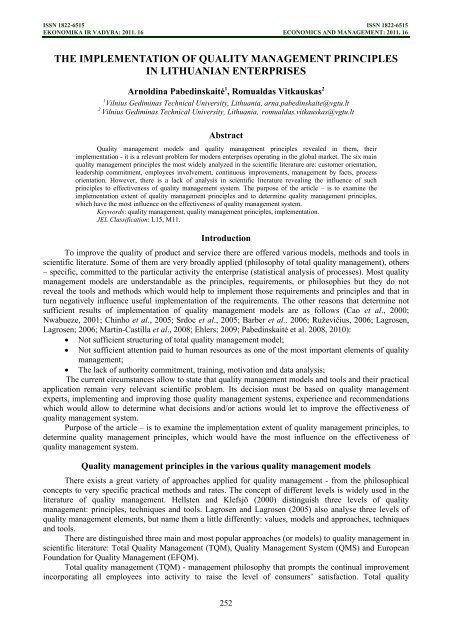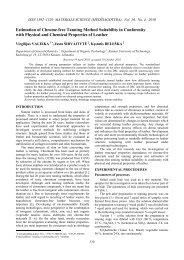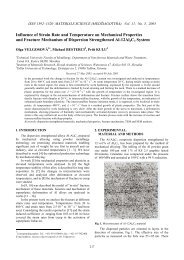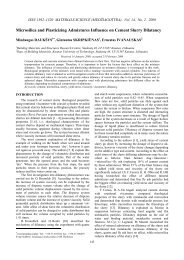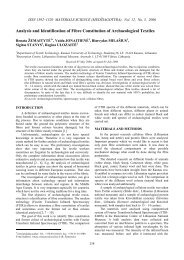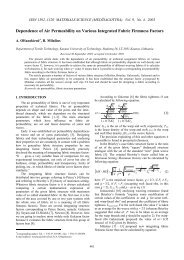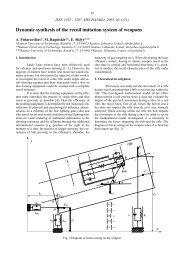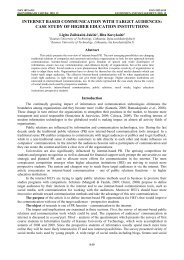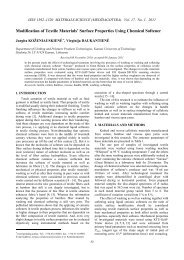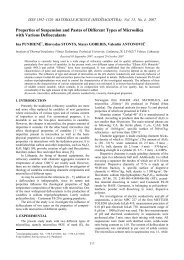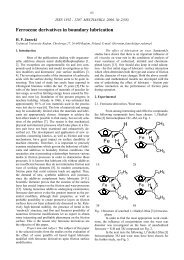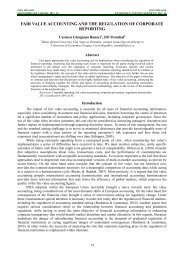the implementation of quality management principles in ... - KTU
the implementation of quality management principles in ... - KTU
the implementation of quality management principles in ... - KTU
You also want an ePaper? Increase the reach of your titles
YUMPU automatically turns print PDFs into web optimized ePapers that Google loves.
ISSN 1822-6515 ISSN 1822-6515<br />
EKONOMIKA IR VADYBA: 2011. 16 ECONOMICS AND MANAGEMENT: 2011. 16<br />
THE IMPLEMENTATION OF QUALITY MANAGEMENT PRINCIPLES<br />
IN LITHUANIAN ENTERPRISES<br />
Arnold<strong>in</strong>a Pabed<strong>in</strong>skaitė 1 , Romualdas Vitkauskas 2<br />
1 Vilnius Gedim<strong>in</strong>as Technical University, Lithuania, arna.pabed<strong>in</strong>skaite@vgtu.lt<br />
2 Vilnius Gedim<strong>in</strong>as Technical University, Lithuania, romualdas.vitkauskas@vgtu.lt<br />
Abstract<br />
Quality <strong>management</strong> models and <strong>quality</strong> <strong>management</strong> <strong>pr<strong>in</strong>ciples</strong> revealed <strong>in</strong> <strong>the</strong>m, <strong>the</strong>ir<br />
<strong>implementation</strong> - it is a relevant problem for modern enterprises operat<strong>in</strong>g <strong>in</strong> <strong>the</strong> global market. The six ma<strong>in</strong><br />
<strong>quality</strong> <strong>management</strong> <strong>pr<strong>in</strong>ciples</strong> <strong>the</strong> most widely analyzed <strong>in</strong> <strong>the</strong> scientific literature are: customer orientation,<br />
leadership commitment, employees <strong>in</strong>volvement, cont<strong>in</strong>uous improvements, <strong>management</strong> by facts, process<br />
orientation. However, <strong>the</strong>re is a lack <strong>of</strong> analysis <strong>in</strong> scientific literature reveal<strong>in</strong>g <strong>the</strong> <strong>in</strong>fluence <strong>of</strong> such<br />
<strong>pr<strong>in</strong>ciples</strong> to effectiveness <strong>of</strong> <strong>quality</strong> <strong>management</strong> system. The purpose <strong>of</strong> <strong>the</strong> article – is to exam<strong>in</strong>e <strong>the</strong><br />
<strong>implementation</strong> extent <strong>of</strong> <strong>quality</strong> <strong>management</strong> <strong>pr<strong>in</strong>ciples</strong> and to determ<strong>in</strong>e <strong>quality</strong> <strong>management</strong> <strong>pr<strong>in</strong>ciples</strong>,<br />
which have <strong>the</strong> most <strong>in</strong>fluence on <strong>the</strong> effectiveness <strong>of</strong> <strong>quality</strong> <strong>management</strong> system.<br />
Keywords: <strong>quality</strong> <strong>management</strong>, <strong>quality</strong> <strong>management</strong> <strong>pr<strong>in</strong>ciples</strong>, <strong>implementation</strong>.<br />
JEL Classification: L15, M11.<br />
Introduction<br />
To improve <strong>the</strong> <strong>quality</strong> <strong>of</strong> product and service <strong>the</strong>re are <strong>of</strong>fered various models, methods and tools <strong>in</strong><br />
scientific literature. Some <strong>of</strong> <strong>the</strong>m are very broadly applied (philosophy <strong>of</strong> total <strong>quality</strong> <strong>management</strong>), o<strong>the</strong>rs<br />
– specific, committed to <strong>the</strong> particular activity <strong>the</strong> enterprise (statistical analysis <strong>of</strong> processes). Most <strong>quality</strong><br />
<strong>management</strong> models are understandable as <strong>the</strong> <strong>pr<strong>in</strong>ciples</strong>, requirements, or philosophies but <strong>the</strong>y do not<br />
reveal <strong>the</strong> tools and methods which would help to implement those requirements and <strong>pr<strong>in</strong>ciples</strong> and that <strong>in</strong><br />
turn negatively <strong>in</strong>fluence useful <strong>implementation</strong> <strong>of</strong> <strong>the</strong> requirements. The o<strong>the</strong>r reasons that determ<strong>in</strong>e not<br />
sufficient results <strong>of</strong> <strong>implementation</strong> <strong>of</strong> <strong>quality</strong> <strong>management</strong> models are as follows (Cao et al., 2000;<br />
Nwabueze, 2001; Ch<strong>in</strong>ho et al., 2005; Srdoc et al., 2005; Barber et al., 2006; Ruževičius, 2006; Lagrosen,<br />
Lagrosen; 2006; Mart<strong>in</strong>-Castilla et al., 2008; Ehlers; 2009; Pabed<strong>in</strong>skaitė et al. 2008, 2010):<br />
• Not sufficient structur<strong>in</strong>g <strong>of</strong> total <strong>quality</strong> <strong>management</strong> model;<br />
• Not sufficient attention paid to human resources as one <strong>of</strong> <strong>the</strong> most important elements <strong>of</strong> <strong>quality</strong><br />
<strong>management</strong>;<br />
• The lack <strong>of</strong> authority commitment, tra<strong>in</strong><strong>in</strong>g, motivation and data analysis;<br />
The current circumstances allow to state that <strong>quality</strong> <strong>management</strong> models and tools and <strong>the</strong>ir practical<br />
application rema<strong>in</strong> very relevant scientific problem. Its decision must be based on <strong>quality</strong> <strong>management</strong><br />
experts, implement<strong>in</strong>g and improv<strong>in</strong>g those <strong>quality</strong> <strong>management</strong> systems, experience and recommendations<br />
which would allow to determ<strong>in</strong>e what decisions and/or actions would let to improve <strong>the</strong> effectiveness <strong>of</strong><br />
<strong>quality</strong> <strong>management</strong> system.<br />
Purpose <strong>of</strong> <strong>the</strong> article – is to exam<strong>in</strong>e <strong>the</strong> <strong>implementation</strong> extent <strong>of</strong> <strong>quality</strong> <strong>management</strong> <strong>pr<strong>in</strong>ciples</strong>, to<br />
determ<strong>in</strong>e <strong>quality</strong> <strong>management</strong> <strong>pr<strong>in</strong>ciples</strong>, which would have <strong>the</strong> most <strong>in</strong>fluence on <strong>the</strong> effectiveness <strong>of</strong><br />
<strong>quality</strong> <strong>management</strong> system.<br />
Quality <strong>management</strong> <strong>pr<strong>in</strong>ciples</strong> <strong>in</strong> <strong>the</strong> various <strong>quality</strong> <strong>management</strong> models<br />
There exists a great variety <strong>of</strong> approaches applied for <strong>quality</strong> <strong>management</strong> - from <strong>the</strong> philosophical<br />
concepts to very specific practical methods and rates. The concept <strong>of</strong> different levels is widely used <strong>in</strong> <strong>the</strong><br />
literature <strong>of</strong> <strong>quality</strong> <strong>management</strong>. Hellsten and Klefsjö (2000) dist<strong>in</strong>guish three levels <strong>of</strong> <strong>quality</strong><br />
<strong>management</strong>: <strong>pr<strong>in</strong>ciples</strong>, techniques and tools. Lagrosen and Lagrosen (2005) also analyse three levels <strong>of</strong><br />
<strong>quality</strong> <strong>management</strong> elements, but name <strong>the</strong>m a little differently: values, models and approaches, techniques<br />
and tools.<br />
There are dist<strong>in</strong>guished three ma<strong>in</strong> and most popular approaches (or models) to <strong>quality</strong> <strong>management</strong> <strong>in</strong><br />
scientific literature: Total Quality Management (TQM), Quality Management System (QMS) and European<br />
Foundation for Quality Management (EFQM).<br />
Total <strong>quality</strong> <strong>management</strong> (TQM) - <strong>management</strong> philosophy that prompts <strong>the</strong> cont<strong>in</strong>ual improvement<br />
<strong>in</strong>corporat<strong>in</strong>g all employees <strong>in</strong>to activity to raise <strong>the</strong> level <strong>of</strong> consumers’ satisfaction. Total <strong>quality</strong><br />
252
ISSN 1822-6515 ISSN 1822-6515<br />
EKONOMIKA IR VADYBA: 2011. 16 ECONOMICS AND MANAGEMENT: 2011. 16<br />
<strong>management</strong> is very extensive conception (Grundey 2008; Vanagas, Vilkas 2008), <strong>of</strong>ten understood as<br />
<strong>management</strong> philosophy and methods that prompt <strong>the</strong> organization to evolve cont<strong>in</strong>ually, <strong>in</strong>clud<strong>in</strong>g <strong>in</strong> such<br />
process all <strong>the</strong> employees and seek<strong>in</strong>g better meet <strong>the</strong> needs <strong>of</strong> consumers, improv<strong>in</strong>g <strong>quality</strong> <strong>of</strong> <strong>the</strong> product<br />
and reduc<strong>in</strong>g costs (Bendell et al. 1995, Dale et al. 1997, Hellsten, Klefsjö 2000, Hansson, Klefsjö 2003;<br />
ergonomics, 2004). Kelemen (2006) claims that <strong>the</strong> ma<strong>in</strong> TQM elements are: commitment <strong>of</strong> <strong>the</strong> highest<br />
authority, cont<strong>in</strong>ual improvement through <strong>the</strong> application <strong>of</strong> scientific knowledge and <strong>in</strong>corporation <strong>of</strong> <strong>the</strong><br />
employees.<br />
Accord<strong>in</strong>g to Barczyk (1999) TQM as whole consists <strong>of</strong> 18 major components. For ease <strong>of</strong> use <strong>the</strong>se<br />
components accord<strong>in</strong>g to <strong>the</strong> mean<strong>in</strong>g are grouped <strong>in</strong>to substantial provisions, grand <strong>pr<strong>in</strong>ciples</strong> (teamwork,<br />
cont<strong>in</strong>uous <strong>in</strong>tegration <strong>of</strong> <strong>the</strong> system, creation <strong>of</strong> <strong>quality</strong> standards, <strong>quality</strong> measurement, cont<strong>in</strong>uous <strong>quality</strong><br />
improvement) <strong>management</strong> tools and <strong>management</strong> measures. Goetsch and Davis (2006) claim that <strong>the</strong>re are<br />
eleven critical elements <strong>of</strong> total <strong>quality</strong> <strong>management</strong>: Strategically based, Customer Focus, Obsession with<br />
Quality, Scientific approach, Long-term commitment, Teamwork, Cont<strong>in</strong>ual Process Improvement,<br />
Education and Tra<strong>in</strong><strong>in</strong>g, Freedom Through Control, Unity <strong>of</strong> Purpose, Employee Involvement and<br />
Empowerment. Basu (2004) highlights <strong>the</strong> <strong>pr<strong>in</strong>ciples</strong> <strong>of</strong> <strong>quality</strong> improvement plann<strong>in</strong>g and cost reduction.<br />
Lagrosens’ (2005) accomplish<strong>in</strong>g <strong>the</strong> analysis <strong>of</strong> scientific literature identifies six ma<strong>in</strong> TQM<br />
<strong>pr<strong>in</strong>ciples</strong> repetitive <strong>in</strong> many <strong>quality</strong> <strong>management</strong> models: Customer orientation, Leadership commitment,<br />
Participation <strong>of</strong> everybody, Cont<strong>in</strong>uous improvements, Management by facts, Process orientation.<br />
Quality Management System (QMS) – is <strong>management</strong> system coord<strong>in</strong>at<strong>in</strong>g enterprise activity <strong>in</strong><br />
pursuit <strong>of</strong> <strong>quality</strong> and implemented <strong>in</strong> accordance with ISO 9000, <strong>the</strong> requirements <strong>of</strong> <strong>in</strong>ternational standard<br />
(Bass, 2004; Pociute et al. 2004). The purpose <strong>of</strong> enterprise implement<strong>in</strong>g QMS - to arrange all proceed<strong>in</strong>g<br />
processes <strong>in</strong> enterprise <strong>in</strong> order to reach better results, <strong>the</strong>refore its f<strong>in</strong>al product would br<strong>in</strong>g <strong>the</strong> enterprise<br />
desirable pr<strong>of</strong>it and completely satisfy consumers needs (Bass, 2004; Pociute et al. 2004; Goetsch et al.<br />
2006). Quality <strong>management</strong> system based on <strong>in</strong>ternational standards is ma<strong>in</strong>ta<strong>in</strong>ed with <strong>the</strong> same six<br />
<strong>pr<strong>in</strong>ciples</strong> mentioned by Lagrosen (2005), only additionally <strong>in</strong>corporated with <strong>pr<strong>in</strong>ciples</strong> <strong>of</strong> systematic<br />
approach and <strong>the</strong> pr<strong>in</strong>ciple <strong>of</strong> mutually beneficial relations with suppliers.<br />
To evaluate <strong>the</strong> <strong>implementation</strong> level <strong>of</strong> <strong>quality</strong> <strong>management</strong> system and <strong>quality</strong> <strong>management</strong><br />
<strong>pr<strong>in</strong>ciples</strong> are used: EFQM model (Eriksson 2003, Foster 2007; Pociute et al. 2004; Vanagas 2004), <strong>the</strong><br />
national <strong>quality</strong> awards or world-class W. E. Dem<strong>in</strong>g or Malcolm Baldrige <strong>quality</strong> awards. The analysis <strong>of</strong><br />
<strong>in</strong>tegrated elements <strong>of</strong> <strong>the</strong>se award models shows that <strong>quality</strong> <strong>management</strong> <strong>pr<strong>in</strong>ciples</strong> are mostly taken <strong>in</strong>to<br />
account <strong>in</strong> EFQM model and Malcolm Baldrige, leastwise – <strong>in</strong> W. E. Dem<strong>in</strong>g prize requirements. This<br />
po<strong>in</strong>ts to that <strong>the</strong> <strong>implementation</strong> <strong>of</strong> <strong>quality</strong> <strong>management</strong> <strong>pr<strong>in</strong>ciples</strong> was pursued progressively.<br />
It is noticed that almost all <strong>quality</strong> <strong>management</strong> <strong>pr<strong>in</strong>ciples</strong> mentioned <strong>in</strong> scientific literature are related<br />
to o<strong>the</strong>r <strong>management</strong> <strong>the</strong>ories: <strong>management</strong> <strong>of</strong> human resources, market<strong>in</strong>g, <strong>management</strong> account<strong>in</strong>g,<br />
production and operations <strong>management</strong>. However, <strong>the</strong> special attention is paid to process orientation<br />
pr<strong>in</strong>ciple.<br />
The application <strong>of</strong> process orientation <strong>in</strong> <strong>quality</strong> <strong>management</strong> models is emphasized as fundamental<br />
pr<strong>in</strong>ciple <strong>of</strong> <strong>quality</strong> <strong>management</strong>. In <strong>the</strong> <strong>in</strong>ternational standard LST EN ISO 9001:2008, where <strong>quality</strong><br />
<strong>management</strong> systems are created <strong>in</strong> accordance with its requirements <strong>the</strong> process orientation is revealed only<br />
<strong>in</strong> two sections (0.2 and 4.1). The standard states that “if organization pursues to operate effectively, it must<br />
identify and manage variety <strong>of</strong> relative activities. Activity or <strong>the</strong> entirety <strong>of</strong> activities us<strong>in</strong>g resources and<br />
managed <strong>in</strong> order to make <strong>the</strong> outcomes <strong>in</strong>to results may be analysed as a process. Often, <strong>the</strong> results <strong>of</strong> one<br />
process directly are <strong>the</strong> outcomes <strong>of</strong> <strong>the</strong> o<strong>the</strong>r process. The systems application <strong>of</strong> organizations processes,<br />
toge<strong>the</strong>r with <strong>the</strong> processes and <strong>the</strong> identification <strong>of</strong> <strong>the</strong>ir <strong>in</strong>teraction and <strong>management</strong> <strong>of</strong> <strong>the</strong> processes,<br />
creat<strong>in</strong>g <strong>the</strong> desirable result can be def<strong>in</strong>ed as a „process orientation”. Apply<strong>in</strong>g process orientation to <strong>quality</strong><br />
<strong>management</strong> system is emphasized <strong>the</strong> importance: to understand and meet <strong>the</strong> requirements; to analyse<br />
processes <strong>in</strong> <strong>the</strong> terms <strong>of</strong> value-added; to determ<strong>in</strong>e (get) <strong>the</strong> data <strong>of</strong> processes current and efficiency, to<br />
improve processes cont<strong>in</strong>ually on <strong>the</strong> basis <strong>of</strong> <strong>the</strong>ir objective measurements. Chapter 4.1. „General<br />
requirements” presents that organization must: „to def<strong>in</strong>e processes needed for <strong>quality</strong> <strong>management</strong> system<br />
and to determ<strong>in</strong>e <strong>the</strong>ir application <strong>in</strong> <strong>the</strong> organization, to def<strong>in</strong>ed <strong>the</strong> sequence <strong>of</strong> <strong>the</strong>se processes and <strong>the</strong>ir<br />
<strong>in</strong>teraction, <strong>the</strong> criterion and methods ensur<strong>in</strong>g <strong>the</strong> effective operation and <strong>management</strong> <strong>of</strong> processes, to<br />
ensure necessary resources and <strong>in</strong>formation needed for <strong>the</strong> process operation and monitor<strong>in</strong>g, to monitor, to<br />
measure (where fits), and to analyze <strong>the</strong>se processes, to implement <strong>the</strong> necessary actions needed to achieve<br />
planned results and cont<strong>in</strong>uously improve processes”. The ma<strong>in</strong> idea <strong>of</strong> <strong>the</strong> process orientation - <strong>the</strong> product<br />
for <strong>the</strong> consumer is created transform<strong>in</strong>g <strong>the</strong> supplier’s materials. In general terms <strong>the</strong> supplier and consumer<br />
253
ISSN 1822-6515 ISSN 1822-6515<br />
EKONOMIKA IR VADYBA: 2011. 16 ECONOMICS AND MANAGEMENT: 2011. 16<br />
are apprehended as - both external and <strong>in</strong>ternal, when <strong>the</strong>re are preced<strong>in</strong>g a number <strong>of</strong> processes <strong>in</strong> <strong>the</strong><br />
enterprise and each process uses <strong>the</strong> product created <strong>in</strong> <strong>the</strong> previously process and, <strong>of</strong> course, each product<br />
must be measured accord<strong>in</strong>g to pre-established criterion. Discover<strong>in</strong>g <strong>the</strong> <strong>in</strong>adequacies <strong>the</strong> corrective actions<br />
must be foreseen and implemented. Therefore, to evaluate any process <strong>the</strong>re must be <strong>in</strong>dicated specific,<br />
measurable criterions and determ<strong>in</strong>ed methods <strong>of</strong> measurement, for example, measur<strong>in</strong>g <strong>the</strong> <strong>quality</strong> <strong>of</strong> <strong>the</strong><br />
product can be used methods <strong>of</strong> multi-criterion assessment (G<strong>in</strong>evičius et al. 2005; G<strong>in</strong>evičius 2007,<br />
Pabed<strong>in</strong>skaitė et al. 2009).<br />
The criterion <strong>of</strong> processes <strong>management</strong> <strong>in</strong> <strong>the</strong> <strong>in</strong>ternal evaluation questionnaire and methodology <strong>of</strong><br />
enterprise activity <strong>in</strong> National Quality Prize (M<strong>in</strong>istry <strong>of</strong> Economy <strong>of</strong> <strong>the</strong> Republic <strong>of</strong> Lithuania, 2010),<br />
which is prepared on <strong>the</strong> basis <strong>of</strong> EFQM model (Eriksson 2003, Foster 2007; Pociute et al. 2004; Vanagas<br />
2004), is divided <strong>in</strong>to five elements (evaluation <strong>of</strong> <strong>the</strong> processes most important to bus<strong>in</strong>ess success; <strong>the</strong><br />
application <strong>of</strong> systematic approach <strong>in</strong> <strong>management</strong>; analysis <strong>of</strong> processes and establishment <strong>of</strong> <strong>the</strong>ir<br />
improvement objectives; improvement <strong>of</strong> <strong>the</strong> processes us<strong>in</strong>g <strong>in</strong>novations and creative work; <strong>implementation</strong><br />
<strong>of</strong> new processes and efficiency evaluation), with provided examples how <strong>the</strong> enterprise could describe a<br />
particular element.<br />
Thus, <strong>the</strong> <strong>quality</strong> <strong>management</strong> <strong>pr<strong>in</strong>ciples</strong> are analyzed <strong>in</strong> scientific literature quite broadly, mostly<br />
focus<strong>in</strong>g on <strong>the</strong> six ma<strong>in</strong> <strong>quality</strong> <strong>management</strong> <strong>pr<strong>in</strong>ciples</strong> and impos<strong>in</strong>g a lot attention to process orientation.<br />
However, <strong>the</strong> <strong>in</strong>fluence <strong>of</strong> <strong>quality</strong> <strong>management</strong> <strong>pr<strong>in</strong>ciples</strong> on <strong>the</strong> effectiveness <strong>of</strong> <strong>quality</strong> <strong>management</strong> system<br />
is not revealed enough.<br />
Research <strong>of</strong> <strong>quality</strong> <strong>management</strong> effectiveness <strong>in</strong> Lithuanian enterprises<br />
The purpose <strong>of</strong> research – to determ<strong>in</strong>e <strong>the</strong> extent to which Lithuanian enterprises implemented <strong>quality</strong><br />
<strong>management</strong> system <strong>in</strong> accordance with ISO 9001 <strong>in</strong>ternational standard are us<strong>in</strong>g <strong>quality</strong> <strong>management</strong><br />
<strong>pr<strong>in</strong>ciples</strong>, to evaluate <strong>the</strong> l<strong>in</strong>k between <strong>the</strong> effectiveness <strong>of</strong> <strong>quality</strong> <strong>management</strong> system and <strong>quality</strong><br />
<strong>management</strong> <strong>pr<strong>in</strong>ciples</strong>, to determ<strong>in</strong>e <strong>the</strong> l<strong>in</strong>k <strong>of</strong> process orientation application and <strong>the</strong> nature <strong>of</strong><br />
improvements and suggestions.<br />
To make <strong>the</strong> research was chosen <strong>the</strong> enterprises from eight different ranges <strong>of</strong> activity (food,<br />
furniture, textile, paper, chemicals materials, metal, build<strong>in</strong>g materials and pharmaceuticals). The sample <strong>of</strong><br />
research – 74 enterprises, <strong>the</strong>ir <strong>quality</strong> <strong>management</strong> experts answered <strong>the</strong> questions from <strong>the</strong> questionnaire;<br />
six <strong>of</strong> <strong>the</strong>m did not <strong>in</strong>dicate <strong>the</strong> name <strong>of</strong> <strong>the</strong> enterprise. Almost all <strong>the</strong> enterprises are classified as small and<br />
medium-sized (18.9% <strong>of</strong> enterprises workforce conta<strong>in</strong>ed from 11 to 50 employees, 56.8% - from 51 to 250<br />
employees, 24.3% - from 251 and more). 68 enterprises from 74 <strong>in</strong>dicated that <strong>the</strong>ir ma<strong>in</strong> activity is<br />
production.<br />
The bigger part <strong>of</strong> enterprises <strong>in</strong>volved <strong>in</strong> <strong>the</strong> research, operate <strong>in</strong> <strong>the</strong> sectors <strong>of</strong> food <strong>in</strong>dustry and<br />
metal process<strong>in</strong>g. The research showed that all enterprises are implemented <strong>quality</strong> <strong>management</strong> system <strong>in</strong><br />
accordance with ISO 9001 <strong>in</strong>ternational standard and six <strong>of</strong> <strong>the</strong>m participated <strong>in</strong> <strong>the</strong> competition <strong>of</strong><br />
Lithuanian national <strong>quality</strong> prize.<br />
Figure 1. Implementation <strong>of</strong> <strong>quality</strong> <strong>management</strong> <strong>pr<strong>in</strong>ciples</strong><br />
The respondents were asked to evaluate <strong>the</strong> effectiveness <strong>of</strong> <strong>quality</strong> <strong>management</strong> systems and<br />
254
ISSN 1822-6515 ISSN 1822-6515<br />
EKONOMIKA IR VADYBA: 2011. 16 ECONOMICS AND MANAGEMENT: 2011. 16<br />
<strong>implementation</strong> <strong>of</strong> <strong>quality</strong> <strong>management</strong> <strong>pr<strong>in</strong>ciples</strong> <strong>in</strong> <strong>the</strong> scale <strong>of</strong> seven po<strong>in</strong>ts (1 po<strong>in</strong>t - very bad, 7 po<strong>in</strong>ts -<br />
very good). 43.2% <strong>of</strong> respondents <strong>in</strong>dicated that <strong>the</strong> efficiency <strong>of</strong> <strong>quality</strong> <strong>management</strong> system or model<br />
would evaluate positively (5 po<strong>in</strong>ts). Implementation <strong>of</strong> <strong>quality</strong> <strong>pr<strong>in</strong>ciples</strong> is considered quite well, because<br />
<strong>the</strong> total average <strong>of</strong> <strong>pr<strong>in</strong>ciples</strong>’ <strong>implementation</strong> seeks 5.53 po<strong>in</strong>ts. Implementation <strong>of</strong> customer orientation<br />
pr<strong>in</strong>ciple is considered to be <strong>the</strong> best - average seeks 6.01 (Fig. 1). Implementation <strong>of</strong> leadership commitment<br />
pr<strong>in</strong>ciple is considered to be <strong>the</strong> worst - 4.76 po<strong>in</strong>ts. The average <strong>of</strong> process orientation pr<strong>in</strong>ciple’s<br />
<strong>implementation</strong> is higher than <strong>the</strong> overall average <strong>of</strong> all <strong>the</strong> <strong>pr<strong>in</strong>ciples</strong> - 5.87.<br />
The made correlation analysis showed that <strong>the</strong>re is a l<strong>in</strong>k between <strong>the</strong> effectiveness <strong>of</strong> <strong>quality</strong><br />
<strong>management</strong> system and <strong>the</strong> scale <strong>of</strong> <strong>quality</strong> <strong>management</strong> <strong>pr<strong>in</strong>ciples</strong>’ <strong>implementation</strong> (Table 1). Accord<strong>in</strong>g to<br />
<strong>the</strong> presented values <strong>of</strong> correlation coefficient we can see that <strong>the</strong> strongest l<strong>in</strong>k exists between <strong>the</strong><br />
effectiveness <strong>of</strong> <strong>quality</strong> <strong>management</strong> system and process orientation pr<strong>in</strong>ciple, <strong>the</strong> weakest - <strong>the</strong> pr<strong>in</strong>ciple <strong>of</strong><br />
<strong>management</strong> by facts, and <strong>the</strong> l<strong>in</strong>k between <strong>the</strong> effectiveness <strong>of</strong> <strong>quality</strong> <strong>management</strong> system and <strong>the</strong><br />
<strong>implementation</strong> level <strong>of</strong> <strong>the</strong> leadership commitment pr<strong>in</strong>ciple is not statistically significant (t = 1,77<br />
t kr =1,99 t=3,59>t kr =1,99 t=3,47>t kr =1,99 t=3,11>t kr =1,99 t=2,63>t kr =1,99<br />
The research showed, that <strong>the</strong> most popular improvement areas <strong>of</strong> processes <strong>in</strong> Lithuanian enterprises<br />
are: 63.5% <strong>of</strong> respondents <strong>in</strong>dicated that <strong>the</strong> most popular area for improvement - <strong>implementation</strong> <strong>of</strong> new<br />
equipment (Fig. 2). 44.6% <strong>of</strong> respondents <strong>in</strong>dicated that <strong>the</strong>y improve <strong>the</strong>ir activity apply<strong>in</strong>g new<br />
technologies, and 47.3% - rais<strong>in</strong>g <strong>the</strong> qualification <strong>of</strong> employees. Respondents <strong>in</strong>dicated that <strong>the</strong> issues<br />
concern<strong>in</strong>g activity improvement are usually resolved through regular meet<strong>in</strong>gs (77% <strong>of</strong> respondents). 37.8%<br />
<strong>of</strong> respondents <strong>in</strong>dicated that <strong>the</strong>re are formed work<strong>in</strong>g groups to analyze <strong>the</strong> alternatives <strong>of</strong> improvement.<br />
Figure 2. Improvement areas <strong>of</strong> processes<br />
The research also showed that enterprises which have evaluated <strong>the</strong> systems effectiveness by 6 po<strong>in</strong>ts<br />
are mostly <strong>in</strong>cl<strong>in</strong>ed to improve qualification <strong>of</strong> employees (48.6%) and implement new equipment (44.7%).<br />
Enterprises which have evaluated <strong>the</strong> systems effectiveness by 5 po<strong>in</strong>ts mostly improve technologies<br />
(42.4%) and work methods (42.3%).<br />
However, <strong>the</strong> correlation analysis showed that correlation l<strong>in</strong>k <strong>of</strong> process orientation pr<strong>in</strong>ciple exists<br />
only with two activities <strong>of</strong> improvement (Table. 2).
ISSN 1822-6515 ISSN 1822-6515<br />
EKONOMIKA IR VADYBA: 2011. 16 ECONOMICS AND MANAGEMENT: 2011. 16<br />
Table 2. The values <strong>of</strong> correlation coefficient between <strong>the</strong> process orientation pr<strong>in</strong>ciple and nature <strong>of</strong><br />
improvement<br />
Improved qualification <strong>of</strong> Improved work<strong>in</strong>g<br />
Process orientation pr<strong>in</strong>ciple (x1) employees (y1)<br />
methods (y2)<br />
0,25178 0,23272<br />
t=2,20>t kr =1,99 t=2,03>t kr =1,99<br />
Consider<strong>in</strong>g <strong>the</strong> results <strong>of</strong> <strong>the</strong> research we can claim that enterprises seek<strong>in</strong>g to <strong>in</strong>crease <strong>the</strong><br />
effectiveness <strong>of</strong> <strong>quality</strong> <strong>management</strong> system must pay particular attention to <strong>the</strong> process orientation approach<br />
which <strong>implementation</strong> is secured rais<strong>in</strong>g <strong>the</strong> qualification <strong>of</strong> employees and improv<strong>in</strong>g work methods.<br />
Conclusions<br />
There are six ma<strong>in</strong> <strong>quality</strong> <strong>management</strong> <strong>pr<strong>in</strong>ciples</strong> <strong>the</strong> most widely analyzed <strong>in</strong> scientific literature:<br />
customer orientation, leadership commitment, employees <strong>in</strong>volvement, cont<strong>in</strong>uous improvement,<br />
<strong>management</strong> by facts, process orientation, but <strong>the</strong>re is a lack <strong>of</strong> analysis reveal<strong>in</strong>g <strong>the</strong> <strong>in</strong>fluence <strong>of</strong> such<br />
<strong>pr<strong>in</strong>ciples</strong> to effectiveness <strong>of</strong> <strong>quality</strong> <strong>management</strong> system.<br />
The made research states that <strong>the</strong> extant <strong>of</strong> <strong>quality</strong> <strong>management</strong> <strong>pr<strong>in</strong>ciples</strong> <strong>in</strong> Lithuania enterprises is<br />
quite large - <strong>the</strong> average <strong>of</strong> <strong>pr<strong>in</strong>ciples</strong>’ <strong>implementation</strong> seeks 5,53 po<strong>in</strong>ts (out <strong>of</strong> seven possible) and <strong>the</strong> most<br />
widely is implemented <strong>the</strong> pr<strong>in</strong>ciple <strong>of</strong> customer orientation. Correlation analysis revealed that <strong>the</strong> strongest<br />
l<strong>in</strong>k is between <strong>the</strong> effectiveness <strong>of</strong> <strong>quality</strong> <strong>management</strong> system and its processes orientation pr<strong>in</strong>ciple.<br />
Analys<strong>in</strong>g <strong>the</strong> l<strong>in</strong>k between <strong>the</strong> process orientation <strong>pr<strong>in</strong>ciples</strong> and nature <strong>of</strong> processes improvement, it was<br />
found that a l<strong>in</strong>k exists between <strong>the</strong> <strong>implementation</strong> level <strong>of</strong> <strong>the</strong> processes orientation pr<strong>in</strong>ciple and<br />
qualification <strong>of</strong> employees and improvement <strong>of</strong> work methods.<br />
References<br />
1. Barber, K. D., Dewhurst, F. W., Burns, R. L. D. H., & Rogers, J. B. B. (2003). Bus<strong>in</strong>ess-process modell<strong>in</strong>g and<br />
simulation for manufactur<strong>in</strong>g <strong>management</strong>: A practical way forward. Bus<strong>in</strong>ess Process Management Journal. 9(4),<br />
527-542.<br />
2. Barczyk, Casimir C. (1999). Visuot<strong>in</strong>ės kokybės vadyba. Vilnius: Eugrimas. 255 p. ISBN 9986053471.<br />
3. Basu, R. (2004). Implement<strong>in</strong>g <strong>quality</strong>. Cornwall: Thomson Learn<strong>in</strong>g. 311 p. ISBN 1844800571.<br />
4. Bendell, T., Penson, R., & Carr, S. (1995). The <strong>quality</strong> gurus – <strong>the</strong>ir approaches described and considered,<br />
Manag<strong>in</strong>g Service Quality 5(6), 44-48.<br />
5. Cao, G., Clarke, S. & Lehaney, B. (2000). A systematic view <strong>of</strong> organisational change and TQM. The TQM<br />
Magaz<strong>in</strong>e 12(3), 186-193.<br />
6. Ch<strong>in</strong>ho, L., & Chuni, W. (2005). Manag<strong>in</strong>g knowledge contributed by ISO 9001:2000. International Journal <strong>of</strong><br />
Quality & Reliability Management. 22(9), 968-985.<br />
7. Dale, B. G., Boaden, R. J., Wilcox, M., & McQuater, R. E. (1997). Susta<strong>in</strong><strong>in</strong>g total <strong>quality</strong> <strong>management</strong>: what are<br />
<strong>the</strong> key issues? The TQM Magaz<strong>in</strong>e 9(5), 372-380.<br />
8. Ehlers, U. D. (2009). Understand<strong>in</strong>g <strong>quality</strong> culture. Quality Assurance <strong>in</strong> Education 17(4), 343-363.<br />
9. Eriksson, H. (2003). Experiences <strong>of</strong> work<strong>in</strong>g with <strong>in</strong>-company <strong>quality</strong> awards: a case study. The TQM Magaz<strong>in</strong>e<br />
15(6), 397-407.<br />
10. Foster, S. Thomas. (2007). Manag<strong>in</strong>g <strong>quality</strong>: <strong>in</strong>tegrat<strong>in</strong>g <strong>the</strong> supply cha<strong>in</strong>. New Jersey: Pearson Education. 568 p.<br />
ISBN 0132206447.<br />
11. G<strong>in</strong>evičius, R. 2007. Sudėt<strong>in</strong>go reišk<strong>in</strong>io struktūrizuotos rodiklių sistemos formavimas, Verslas: teorija ir praktika:<br />
8(2): 68-72.<br />
12. G<strong>in</strong>evičius, R., & Podvezko, V. (2005). Daugiakriter<strong>in</strong>io vert<strong>in</strong>imo rodiklių sistemos formavimas. Verslas: teorija<br />
ir praktika 6(4), 199-207.<br />
13. Goetsch, D. L., & Davis, S. B. (2006). Quality <strong>management</strong>: Introduction to Total Quality Management for<br />
Production, Process<strong>in</strong>g, and Services. New Jersey: Pearson Prentice Hall. 814 p. ISBN 0131971344.<br />
14. Hellsten, U., & Klefsjö, B. (2000). TQM as a <strong>management</strong> consist<strong>in</strong>g <strong>of</strong> values, techniques and tools. The TQM<br />
Magaz<strong>in</strong>e 12(4), 238-244.<br />
15. Kelemen, M. (2006). Manag<strong>in</strong>g <strong>quality</strong>: managerial and critical perspectives. London: Sage Publications. ISBN<br />
0761969047.<br />
256
ISSN 1822-6515 ISSN 1822-6515<br />
EKONOMIKA IR VADYBA: 2011. 16 ECONOMICS AND MANAGEMENT: 2011. 16<br />
16. Lagrosen, Y., & Lagrosen, S. (2005). The effects <strong>of</strong> <strong>quality</strong> <strong>management</strong> – a survey <strong>of</strong> Swedish <strong>quality</strong><br />
pr<strong>of</strong>essionals. International Journal <strong>of</strong> Operations & Production Management 25(10), 940-952.<br />
17. Lagrosen, S., & Lagrosen, Y. (2006). A dive <strong>in</strong>to <strong>the</strong> depths <strong>of</strong> <strong>quality</strong> <strong>management</strong>. European Bus<strong>in</strong>ess Review<br />
18(2), 84-96.<br />
18. M<strong>in</strong>istry <strong>of</strong> Economy <strong>of</strong> <strong>the</strong> Republic <strong>of</strong> Lithuania (Lietuvos Respublikos ūkio m<strong>in</strong>isterija) [onl<strong>in</strong>e] [accessed 8<br />
August 2010]. Available from <strong>in</strong>ternet: .<br />
19. Mart<strong>in</strong>-Castilla, J.,I., & Rodriguez-Ruiz, O. (2008). EFQM model: knowledge governance and competitive<br />
advantage. Journal <strong>of</strong> Intellectual Capital. 9(1), 133-156.<br />
20. Nwabueze, U. (2001). An <strong>in</strong>dustry betrayed: <strong>the</strong> case <strong>of</strong> total <strong>quality</strong> <strong>management</strong> <strong>in</strong> manufactur<strong>in</strong>g. The TQM<br />
Magaz<strong>in</strong>e 13(6), 400-408.<br />
21. Pabed<strong>in</strong>skaitė, A., & Vitkauskas, R. (2008). Interrelationships between <strong>quality</strong> <strong>management</strong> and knowledge<br />
<strong>management</strong>, <strong>in</strong> Selected papers <strong>of</strong> 49th International Scientific Conference <strong>of</strong> Riga Technical University „The<br />
Problems <strong>of</strong> Development <strong>of</strong> National Economy and Entrepreneurship”. Riga, Latvia, October 9–13, p. 120–121.<br />
22. Pabed<strong>in</strong>skaitė, A., & Vitkauskas, R. (2009). Daugiakriter<strong>in</strong>is produkto kokybės vert<strong>in</strong>imas., Verslas: teorija ir<br />
praktika 10(3), 214-222.<br />
23. Pabed<strong>in</strong>skaitė, A., & Vitkauskas, R. (2010). Quality <strong>management</strong> tools: analysis <strong>of</strong> Lithuanian enterprises. Selected<br />
Papers <strong>of</strong> <strong>the</strong> 6th International Scientific Conference „Bus<strong>in</strong>ess and Management 2010”2, 905–912.<br />
24. Pociūtė, D. J., Janušauskienė, V., & Vitkauskas, R. (2004). Kokybės vadyba. Teorija ir praktika. Vilnius: Technika.<br />
209 p. ISBN 9986057817.<br />
25. Ruževičius, J. (2006). Kokybės vadybos modeliai ir jų taikymas organizacijos veiklos tobul<strong>in</strong>imui. Vilnius: VU<br />
leidykla. 214 p. ISBN 9986198372.<br />
26. Srdoc, A., Sluga, A., & Bratko, I. (2005). A <strong>quality</strong> <strong>management</strong> model based on <strong>the</strong> „deep <strong>quality</strong> concept”.<br />
International Journal <strong>of</strong> Quality & Reliability Management 22(3), 278-302.<br />
27. Vanagas, P. (2004). Visuot<strong>in</strong>ės kokybės vadyba. Kaunas: Technologija. 426 p. ISBN 9955097485.<br />
257


